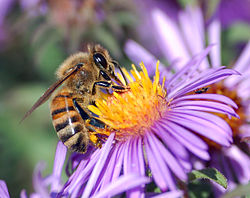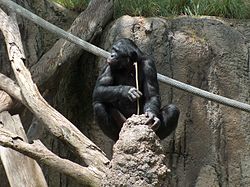Foraging
Foraging is the act of hunting or gathering food. For example, cattle forage grass to eat. The idea of animals foraging is called forage theory, and was first proposed in 1966.[1][2][3]
Humans that forage are often called hunter-gatherers, who find and eat (wild) animals and plants without domestication of them (people who farm plants are not hunter-gatherers, as they have grown them themselves).
Foraging Media
Grizzly bear (Ursus arctos horribilis) mother and cubs foraging in Denali National Park, Alaska.
A troop of olive baboons (Papio anubis) foraging in Laikipia, Kenya. Young primates learn from elders in their group about proper foraging.
A European honey bee extracts nectar. According to Hunt (2007), two genes have been associated with the sugar concentration of the nectar honey bees collect.
A male northern cardinal at a bird feeder. Birds feeding at a bird feeder is an example of a dispersion economy. This is when it may not be in an animal's best interest to forage in a group.
Female lions make foraging decisions and more specifically decisions about hunting group size with protection of their cubs and territory defense in mind.
References
- ↑ Emlen J. M (1966), "The role of time and energy in food preference", The American Naturalist, 100 (916): 611–617, doi:10.1086/282455, JSTOR 2459299, S2CID 85723900
- ↑ Hughes, Roger N, ed. (1989), Behavioural mechanisms of food selection, London & New York, p. v, ISBN 0-387-51762-6
- ↑ MacArthur R.H. & Pianka E.R (1966), "On the optimal use of a patchy environment.", The American Naturalist, 100 (916): 603–9, doi:10.1086/282454, JSTOR 2459298, S2CID 86675558





